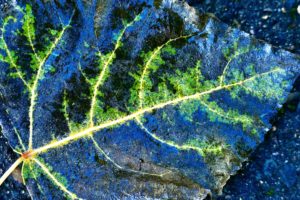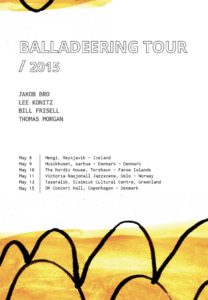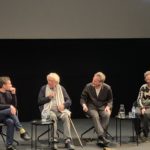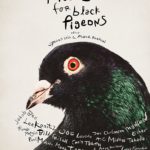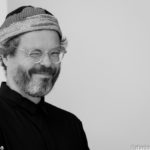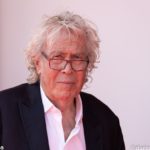(c) FoBo_
Sunday morning I went to the last screening of this documentary at IDFA in Amsterdam with musical friends. It went much deeper than the first time. Tears were flowing … The episodes touch on higher questions in such a down-to-earth way! For instance, when Lee Konitz (1927-2020) leaving the venue in Sisimiut*, Greenland, the Taseralik Culture Center, notice an unguarded baby in a buggy outside. He is surprised to see the baby ‘left alone’ there in the cold. Someone then tells Konitz that it is normal to do that: “The father is inside the building to buy vinyl records. The baby sleeps and is even snoring.”** Puzzled Lee walks towards the buggy to check it. And indeed the Inuit baby, wrapped up warm, sleeps blissfully in the buggy, wonderfully softly snoring. Lee looks in astonishment for a moment and then wishes the baby a happy life before entering the car with his bag containing his alto saxophone. It’s a little daily life scene having a deep impact within the context it is perceived.
The documentary wanders from little moments like this quickly changing from one to another but laying embedded in the quiet, trustful flow of Bros’s music both mutually illuminating each other. The music gives space to the successive episodes and binds them. It is significant that the creation of Bro’s tribute to trumpeter Tomasz Stanko (1942-2018) with whom he played, emerges from a situation in the film with a child, from s scene where Bro plays with his little son.
The jump cuts continuously open surprising, touching turns that draw the viewer deeper into the temperaments and personal life sides of the musicians. Especially the character of Lee Konitz and his special creativity gets contour this way. It is a trade mark of Jørgen Leth’s narrative style fusing here with Bro’s musical flow and Andreas Koefoed’s dynamics and views in productive, illuminating ways. There are lots of these moments: in the recording studio, at home, during travels, that come alive through being combined with each other in that surprising way in the documentary revealing deeper layers then. Sometimes it is just mutual joyful gazes of the musicians at the end of a take in the studio – as for example when Paul Motian proposes to play a piece again and slower. It’s a magic moment but it is not lengthened or heightened but leads into the next jump cut. There is no hierarchy in the cuts and just that creates the magics here. A lot of filmed everyday life situations get significance through their connection with different kinds of pictures, for example musicians’ self statements given in front of a blank wall. It wouldn’t be good to tell more about the magic ‘moments’ in the documentary because doing it would damage the discovery feeling of viewers of future screenings.
It all comes forth from the the special way Koefoed and Leth filmed where and when, thereby collecting sensitive material from which this concentrated, magical documentary could be distilled and assembled. It is a fantastic, productive combination of method and intuition at work here. The oldest footage is from 2008 when Andreas Koefoed started to follow Bro by filming. Leth came in from 2015 on when making an extensive documentary got shape.
The documentary shows that Bro has a special gift to gather people in music making that goes beyond the conventional recording or concert situation. It apparently brings musicians who join and commit themselves to it, enter a primal situation. And, in a way with the documentary the same can happen with viewers.
The documentary will be screened on Documentary/Film festival and several Jazz Festival in 2023.
* Sisimiut is the second city (5600 inhabitants) on Greenland after the capital Nuuk. It was part of a Nordic tour, the Balladeering tour, of Bro’s group with Bill Frisell, Lee Konitz, Thomas Morgan, Lee Konitz via Faroe Islands, Iceland, Norway, Greenland back to Copenhagen in may 2015. I considered to join the group for that unique tour but it did not work out. Finally I attended the last concert of that tour at Danish Radio Concert Hall in Copenhagen together with my son who was studying in those days in Copenhagen.
There is a piece „Sisimiut“ on Bro’s album STREAMS from 2015. It’s on YouTube Premium.
** It is quite common use in Denmark to leave babies unguarded outside in their buggy.
